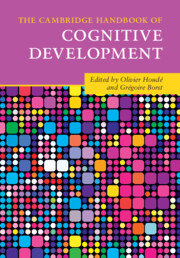Book contents
- The Cambridge Handbook of Cognitive Development
- The Cambridge Handbook of Cognitive Development
- Copyright page
- Contents
- Figures
- Tables
- Contributors
- Introduction
- Part I Neurobiological Constraints and Laws of Cognitive Development
- Part II Fundamentals of Cognitive Development from Infancy to Adolescence and Young Adulthood
- Introduction
- Subpart II.1 Infancy: The Roots of Human Thinking
- 7 Differences between Humans, Great Apes and Monkeys in Cognition, Communication, Language and Morality
- 8 Infants’ Physical Reasoning and the Cognitive Architecture that Supports It
- 9 Infant Categorization
- 10 Foundational Considerations
- 11 How Sophisticated Is Infants’ Theory of Mind?
- 12 Social Cognition and Moral Evaluation in Early Human Childhood
- 13 Scientific Thinking and Reasoning in Infants and Young Children
- 14 Computational Approaches to Cognitive Development
- Subpart II.2 Childhood and Adolescence: The Development of Human Thinking
- Part III Education and School-Learning Domains
- Index
- Plate Section (PDF Only)
- References
12 - Social Cognition and Moral Evaluation in Early Human Childhood
from Subpart II.1 - Infancy: The Roots of Human Thinking
Published online by Cambridge University Press: 24 February 2022
- The Cambridge Handbook of Cognitive Development
- The Cambridge Handbook of Cognitive Development
- Copyright page
- Contents
- Figures
- Tables
- Contributors
- Introduction
- Part I Neurobiological Constraints and Laws of Cognitive Development
- Part II Fundamentals of Cognitive Development from Infancy to Adolescence and Young Adulthood
- Introduction
- Subpart II.1 Infancy: The Roots of Human Thinking
- 7 Differences between Humans, Great Apes and Monkeys in Cognition, Communication, Language and Morality
- 8 Infants’ Physical Reasoning and the Cognitive Architecture that Supports It
- 9 Infant Categorization
- 10 Foundational Considerations
- 11 How Sophisticated Is Infants’ Theory of Mind?
- 12 Social Cognition and Moral Evaluation in Early Human Childhood
- 13 Scientific Thinking and Reasoning in Infants and Young Children
- 14 Computational Approaches to Cognitive Development
- Subpart II.2 Childhood and Adolescence: The Development of Human Thinking
- Part III Education and School-Learning Domains
- Index
- Plate Section (PDF Only)
- References
Summary
Human social cognition is the human capacity to process social stimuli, to intentionally convey socially relevant information to others, and to make use of socially transmitted information. Several human social cognitive capacities are special and set humans apart from non-human animals. Thanks to these capacities, humans are unique in their ability to create, maintain, and alter large social groups within which they coordinate, cooperate, and also compete. Moreover, there are few (if any) other biological species in which groups or crowds of individuals spend as much collective effort in attacking other groups or in defending their own group from the attacks of others (Boyer, 2018; Tooby & Cosmides, 2010). Humans also appear to be unique in their capacity for stable cultural transmission over many generations and for the pervasiveness of their moral cognitive concerns.
- Type
- Chapter
- Information
- The Cambridge Handbook of Cognitive Development , pp. 269 - 298Publisher: Cambridge University PressPrint publication year: 2022



